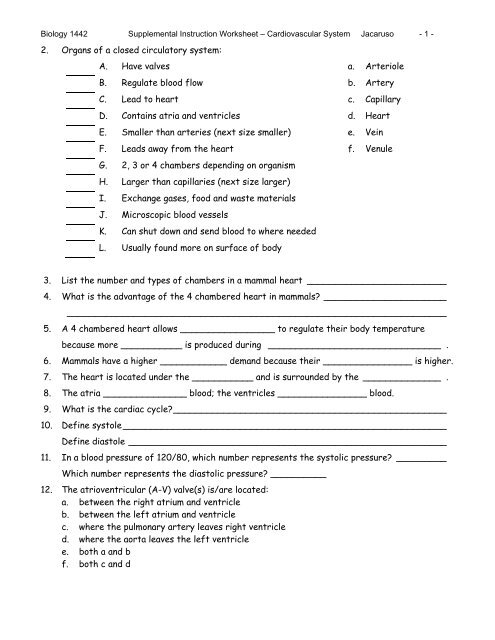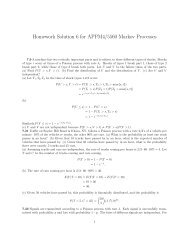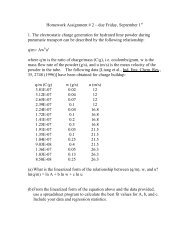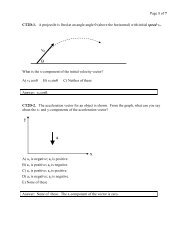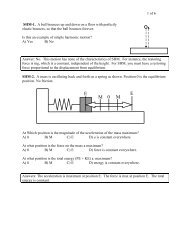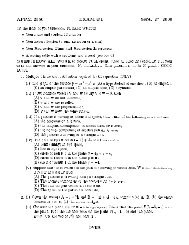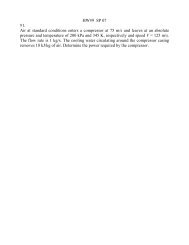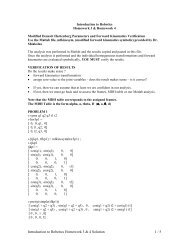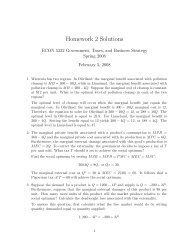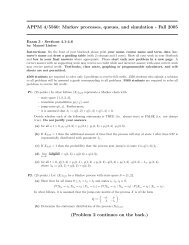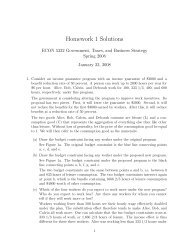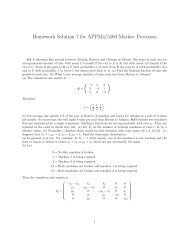2. Organs of a closed circulatory system: A. Have valves a ... - cribME!
2. Organs of a closed circulatory system: A. Have valves a ... - cribME!
2. Organs of a closed circulatory system: A. Have valves a ... - cribME!
You also want an ePaper? Increase the reach of your titles
YUMPU automatically turns print PDFs into web optimized ePapers that Google loves.
Biology 1442 Supplemental Instruction Worksheet – Cardiovascular System Jacaruso - 1 -<br />
<strong>2.</strong> <strong>Organs</strong> <strong>of</strong> a <strong>closed</strong> <strong>circulatory</strong> <strong>system</strong>:<br />
A. <strong>Have</strong> <strong>valves</strong> a. Arteriole<br />
B. Regulate blood flow b. Artery<br />
C. Lead to heart c. Capillary<br />
D. Contains atria and ventricles d. Heart<br />
E. Smaller than arteries (next size smaller) e. Vein<br />
F. Leads away from the heart f. Venule<br />
G. 2, 3 or 4 chambers depending on organism<br />
H. Larger than capillaries (next size larger)<br />
I. Exchange gases, food and waste materials<br />
J. Microscopic blood vessels<br />
K. Can shut down and send blood to where needed<br />
L. Usually found more on surface <strong>of</strong> body<br />
3. List the number and types <strong>of</strong> chambers in a mammal heart _________________________<br />
4. What is the advantage <strong>of</strong> the 4 chambered heart in mammals? ______________________<br />
____________________________________________________________________<br />
5. A 4 chambered heart allows _________________ to regulate their body temperature<br />
because more ___________ is produced during _______________________________ .<br />
6. Mammals have a higher ____________ demand because their ________________ is higher.<br />
7. The heart is located under the ___________ and is surrounded by the ______________ .<br />
8. The atria _______________ blood; the ventricles ________________ blood.<br />
9. What is the cardiac cycle? _________________________________________________<br />
10. Define systole __________________________________________________________<br />
Define diastole _________________________________________________________<br />
11. In a blood pressure <strong>of</strong> 120/80, which number represents the systolic pressure? _________<br />
Which number represents the diastolic pressure? __________<br />
1<strong>2.</strong> The atrioventricular (A-V) valve(s) is/are located:<br />
a. between the right atrium and ventricle<br />
b. between the left atrium and ventricle<br />
c. where the pulmonary artery leaves right ventricle<br />
d. where the aorta leaves the left ventricle<br />
e. both a and b<br />
f. both c and d
Biology 1442 Supplemental Instruction Worksheet – Cardiovascular System Jacaruso - 2 -<br />
13. The semilunar valve(s) is/are located:<br />
a. between the right atrium and ventricle<br />
b. between the left atrium and ventricle<br />
c. where the pulmonary artery leaves right ventricle<br />
d. where the aorta leaves the left ventricle<br />
e. both a and b<br />
f. both c and d<br />
14. What is the function <strong>of</strong> a valve? _____________________________________________<br />
15. What happens when someone has a heart murmur? _______________________________<br />
16. Heart rate (beats/min) x stroke volume (vol/beat) = ______________________(vol/min)<br />
17. The sinoatrial (S-A) node is also called the _________________ <strong>of</strong> the heart because it<br />
_______________________________.<br />
18. The S-A node generates electrical impulses and initiates contraction <strong>of</strong> the ___________ .<br />
The electrical impulse moves to the ___________________________ and completes atrial<br />
contraction. The electrical impulse moves to the Bundle <strong>of</strong> His which divides and sends the<br />
impulse to the right and left bundle branches and Purkinje fibers causing the ___________<br />
to contract.<br />
19. Indicate the location <strong>of</strong> the S-A and A-V nodes:<br />
S-A ____________________________ A-V _______________________________<br />
20. What records the electrical activity <strong>of</strong> the heart? _______________________________<br />
21. The heart rate set by the S-A node can be influenced by _________________________ .<br />
2<strong>2.</strong> Rate change in heart:<br />
A. Increases heart rate when frightened a. Body temperature<br />
B. Nerves that speed up heart rate b. Epinephrine<br />
C. Increase <strong>of</strong> 1°C increases heart rate 10 bpm c. Parasympathetic<br />
D. Nerves that lower heart rate d. Sympathetic<br />
Use the following blood vessel choices to answer questions 23 - 29.<br />
a. artery b. arteriole c. capillary d. venule e. vein<br />
23. Which has the most surface area and the slowest blood flow?_____<br />
24. Which two vessels lead into and away from capillaries?________<br />
25. Which has precapillary sphincters?_____<br />
26. Which has a high pressure and rapid blood flow?_____<br />
27. Which has <strong>valves</strong>?_____<br />
28. Which one is squeezed by muscles to help move the blood?_____<br />
29. A bruise is an injury to a collection <strong>of</strong> which blood vessels?_____
Biology 1442 Supplemental Instruction Worksheet – Cardiovascular System Jacaruso - 3 -<br />
30. Electrical activity in the heart. (1) Label the nodes and specialized muscle fibers<br />
(underlined). (2) Add arrows to indicate the direction the impulse is spreading.<br />
1. Sinoatrial node initiates contraction <strong>of</strong> both atria.<br />
<strong>2.</strong> Electrical impulse moves to atrioventricular node and completes atrial contraction.<br />
3. Electrical impulse moves to Bundle <strong>of</strong> His which divides and<br />
4. sends impulse to right and left bundle branches.<br />
5. Electrical impulse travels to Purkinje fibers and both ventricles contract.
Biology 1442 Supplemental Instruction Worksheet – Cardiovascular System Jacaruso - 4 -<br />
31. In which arteries can a pulse be detected? _____________________________________<br />
What is measured by a pulse? ______________________________________________<br />
3<strong>2.</strong> Contraction <strong>of</strong> smooth muscles in which blood vessel increases blood pressure in the arteries?<br />
__________________<br />
33. Blood pressure is higher in ________________ and lower in _____________________ .<br />
34. Blood pressure is the _________________ force that blood puts on vessel walls and is<br />
greatest at the ________________ end <strong>of</strong> capillaries. It forces ___________ and<br />
______________ through clefts in capillaries to interstitial fluid.<br />
35. About ________ <strong>of</strong> the fluid reenters by ______________ near the ________________.<br />
36. The remaining fluid goes to the _________________ <strong>system</strong> which drains into the<br />
____________________ <strong>system</strong> at the __________________ vein.
Biology 1442 Supplemental Instruction Worksheet – Cardiovascular System Jacaruso - 5 -<br />
37. Flow <strong>of</strong> blood. Label the vessels and heart structures (underlined words) involved in flow <strong>of</strong><br />
blood. Draw blue arrows to show flow <strong>of</strong> deoxygenated blood. Draw red arrows to show flow<br />
<strong>of</strong> oxygenated blood. (If you don’t have these colors, provide the key to your color scheme.)<br />
1. Blood comes from the upper and lower body tissues via capillaries. (Blood has ↓O2, ↑CO2)<br />
<strong>2.</strong> Blood goes to venules.<br />
3. Blood from the upper body goes to the superior vena cava and from the lower body to the<br />
inferior vena cava.<br />
4. Blood enters the right atrium.<br />
5. Blood enters the right ventricle through the right atrioventricular valve.<br />
6. Blood enters the right and left pulmonary arteries through the semilunar valve.<br />
7. Blood goes to the lungs and capillary beds. It gets oxygenated and CO2 is released.<br />
8. Blood returns to the heart via right and left pulmonary veins.<br />
9. Blood enters left atrium.<br />
10. Blood enters left ventricle through the left atrioventricular valve.<br />
11. Blood enters the aorta through the semilunar valve.<br />
1<strong>2.</strong> Blood goes to the arteries.<br />
13. Blood goes to the arterioles.<br />
14. Blood enters capillary beds in the upper and lower body tissues. (Blood has ↑O2, ↓CO2)<br />
Oxygen is diffused into the tissues and CO2 is removed from the tissues.
Biology 1442 Supplemental Instruction Worksheet – Cardiovascular System Jacaruso - 6 -<br />
38. Which sequence most accurately describes a sequence <strong>of</strong> blood flow?______<br />
a. right atrium right ventricle pulmonary artery<br />
b. right atrium left atrium left ventricle aorta<br />
c. left atrium left ventricle pulmonary artery<br />
d. left ventricle left atrium aorta<br />
e. right atrium right ventricle aorta<br />
39. Which sequence most accurately describes a sequence <strong>of</strong> blood flow?______<br />
a. pulmonary vein pulmonary artery right atrium<br />
b. pulmonary artery left atrium left ventricle<br />
c. pulmonary artery pulmonary capillaries pulmonary vein left atrium<br />
d. left ventricle aorta pulmonary artery<br />
e. pulmonary artery pulmonary capillaries pulmonary vein right atrium<br />
40. Blood Clotting Mechanism<br />
____________________________ (from injury) release ______________________<br />
(enzyme; activator) which combines with __________________ (produced by liver;<br />
inactive) + _________________ + vitamin K (normal plasma constituent; inactive)<br />
forming ___________________ (enzyme; active) which reacts with<br />
_____________________ (blood protein produced by liver; inactive) forming<br />
_______________ (thread-like material that catches RBCs and forms clot; active).<br />
41. Cardiovascular Disease<br />
A. Clot in blood vessel in brain a. Myocardial infarction<br />
B. Plaque deposits on inner walls <strong>of</strong> arteries b. Fibrillation<br />
C. Blockage in heart artery c. Stroke<br />
D. Silent killer; promotes atherosclerosis d. Hemorrhagic stroke<br />
E. Ruptured blood vessel in brain e. Atherosclerosis<br />
F. Hardened plaque deposits in artery walls f. Arteriosclerosis<br />
G. Heart quivers during MI; no blood pumped g. Angina pectoris<br />
H. Symptom <strong>of</strong> atherosclerosis and arteriosclerosis h. Hypertension
Biology 2402 Supplemental Instruction Worksheet Jacaruso - 7 -<br />
4<strong>2.</strong> Whole Blood<br />
POS. IONS<br />
Potassium<br />
Sodium<br />
Magnesium<br />
NEG. IONS<br />
Chloride<br />
Bicarbonate<br />
Phosphate<br />
COMPONENTS OF WHOLE BLOOD<br />
PLASMA<br />
Other Substances<br />
Buffering<br />
Osmotic potential<br />
Buffer<br />
Viscosity<br />
Osmotic<br />
potential<br />
Antibody<br />
production<br />
Escorts<br />
for lipids<br />
Blood<br />
clotting<br />
Sugars<br />
Amino acids<br />
Fatty acids<br />
Glycerol<br />
Urea<br />
Cholesterol<br />
Homocysteine<br />
CO2 N<br />
Biconcave<br />
No nucleus<br />
Life span 3-4 mos<br />
No mitochondria<br />
Produced in bone<br />
marrow at ends<br />
<strong>of</strong> long bones<br />
Oxygen transport<br />
(in hemoglobin – iron<br />
containing priotein)<br />
Amoeboid movement<br />
Often outside <strong>of</strong><br />
circ. <strong>system</strong><br />
Phagocytosis <strong>of</strong><br />
bacteria and debris<br />
CELLULAR ELEMENTS<br />
Allergic<br />
reactions<br />
Immune response<br />
Cell fragments<br />
Blood clotting
Biology 2402 Supplemental Instruction Worksheet Jacaruso - 8 -<br />
Answer Key<br />
<strong>2.</strong> (A) e; (B) a; (C) e; (D) d; (E) a; (F) b; (G) d; (H) f; (I) c; (J) c; (K) a; (L) e<br />
3. 2 atria, 2 ventricles<br />
4. no mixing <strong>of</strong> oxygenated and unoxygenated blood; more efficient in sending oxygenated blood<br />
to body tissues<br />
5. endotherms; heat; cellular respiration<br />
6. oxygen; metabolism<br />
7. sternum; pericardium<br />
8. collect; pump<br />
9. alternating sequence – filling atria with blood and pumping blood from ventricles<br />
10. systole – contraction <strong>of</strong> heart; diastole – relaxation <strong>of</strong> heart<br />
11. 120 – systolic pressure; 80 – diastolic pressure<br />
1<strong>2.</strong> e<br />
13. f<br />
14. prevents back flow <strong>of</strong> blood<br />
15. <strong>valves</strong> are not closing properly; blood is flowing back<br />
16. cardiac output<br />
17. pacemaker; sets contraction rate<br />
18. atria; atrioventricular node; ventricles<br />
19. S-A – wall <strong>of</strong> right atrium; A-V – wall between right atrium and right ventricle<br />
20. electrocardiogram<br />
21. nerves, hormones, body temperature<br />
2<strong>2.</strong> (A) b; (B) d; (C) a; (D) c<br />
23. c<br />
24. b, d<br />
25. b<br />
26. a<br />
27. e<br />
28. e<br />
29. c<br />
30. see next page<br />
31. carotid arteries in neck and radial arteries in wrists; heart rate<br />
3<strong>2.</strong> arterioles<br />
33. arteries; veins<br />
34. hydrostatic; arteriole; water; solutes<br />
35. 85%; osmosis; venule<br />
36. lymphatic; <strong>circulatory</strong>; subclavian<br />
37. see next page<br />
38. a<br />
39. c
Biology 2402 Supplemental Instruction Worksheet Jacaruso - 9 -<br />
40. Platelets and damaged cells (from injury) release thromboplastin (enzyme; activator)<br />
Which combines with prothrombin (produced by liver; inactive) + calcium + vitamin K<br />
(normal plasma constituent; inactive) forming thrombin (enzyme; active) which reacts with<br />
fibrinogen (blood protein produced by liver; inactive) forming fibrin (thread-like material<br />
that catches RBCs and forms clot; active).<br />
41. (A) c; (B) e; (C) a; (D) h; (E) d; (F) f; (G) b; (H) g<br />
30. Heart electrical activity<br />
37. Heart and blood circulation<br />
NOTE: Questions 38-39 are taken from Biology, 5th ed., Solomon, Berg and Martin, 1999, pg. 927
Biology 2402 Supplemental Instruction Worksheet Jacaruso - 10 -<br />
4<strong>2.</strong> Whole Blood<br />
POS. IONS<br />
Potassium<br />
Sodium<br />
Magnesium<br />
COMPONENTS OF WHOLE BLOOD<br />
PLASMA<br />
Electrolytes Other Substances<br />
Plasma Proteins<br />
NEG. IONS<br />
Chloride<br />
Bicarbonate<br />
Phosphate<br />
Buffering<br />
Osmotic potential<br />
Biconcave<br />
No nucleus<br />
Life span 3-4 mos<br />
No mitochondria<br />
Erythrocytes<br />
(Red blood cells)<br />
Produced in bone<br />
marrow at ends<br />
<strong>of</strong> long bones<br />
Oxygen transport<br />
(in hemoglobin – iron<br />
containing priotein)<br />
Albumin<br />
Buffer<br />
Viscosity<br />
Osmotic<br />
potential<br />
Immunoglobulins Lipoproteins Prothrombin<br />
Fibrinogen<br />
Antibody<br />
production<br />
Amoeboid movement<br />
Often outside <strong>of</strong><br />
circ. <strong>system</strong><br />
Monocytes<br />
Neutrophils<br />
Phagocytosis <strong>of</strong><br />
bacteria and debris<br />
Escorts<br />
for lipids<br />
CELLULAR ELEMENTS<br />
Basophils<br />
Eosinophils<br />
Allergic<br />
reactions<br />
Blood<br />
clotting<br />
Leukocytes<br />
(white blood cells)<br />
Organic<br />
Nutrients<br />
Sugars<br />
Amino acids<br />
Fatty acids<br />
Glycerol<br />
Lymphocytes<br />
B-cells<br />
Mature in bone<br />
Nitrogenous<br />
waste<br />
Urea<br />
Cholesterol<br />
Homocysteine<br />
T-cells<br />
Mature in thymus<br />
Immune response<br />
Gases<br />
CO 2<br />
N<br />
Platelets<br />
Cell fragments<br />
Blood clotting


